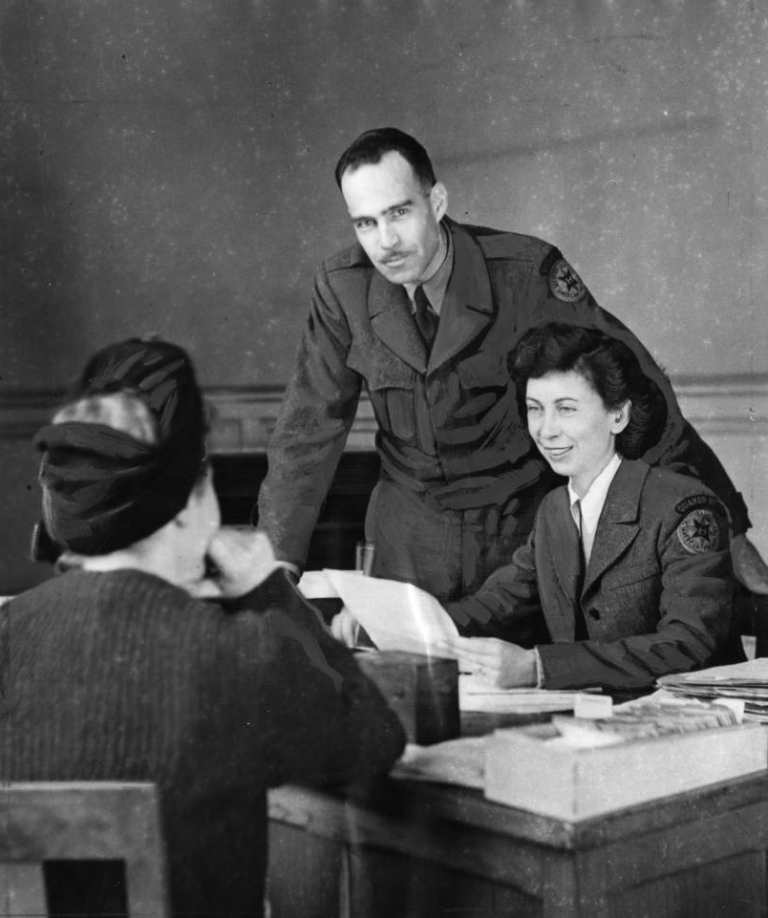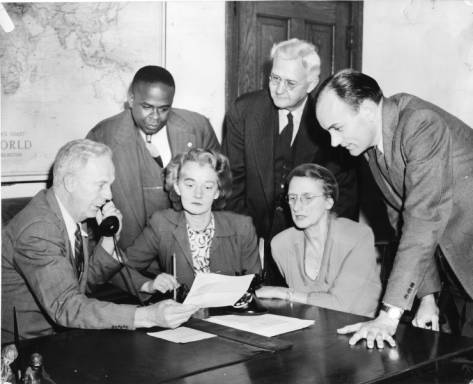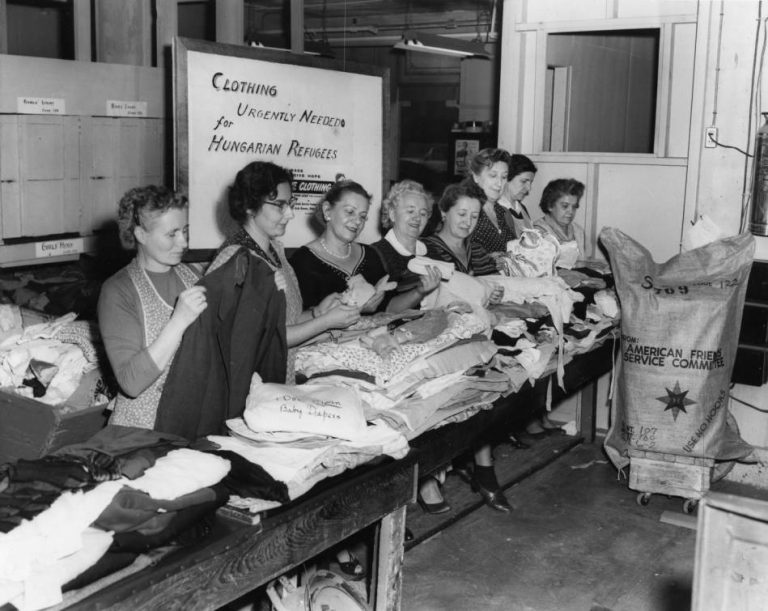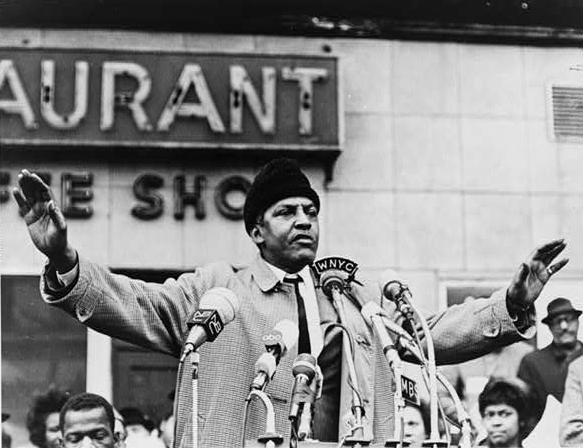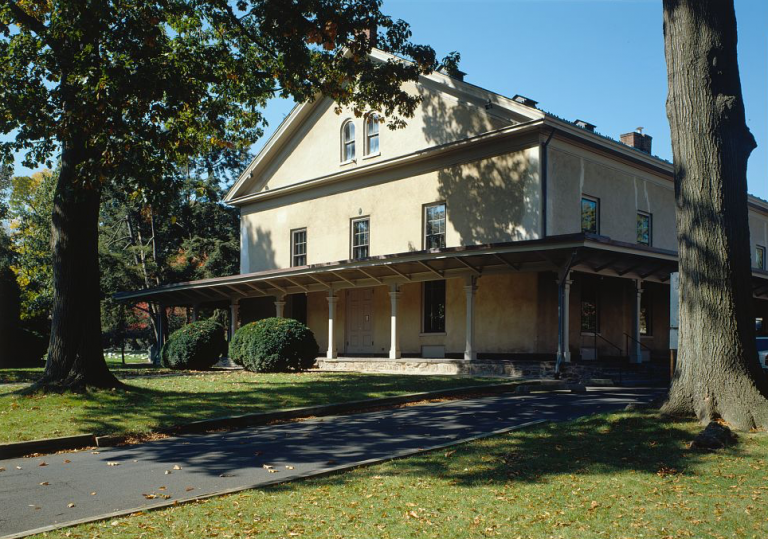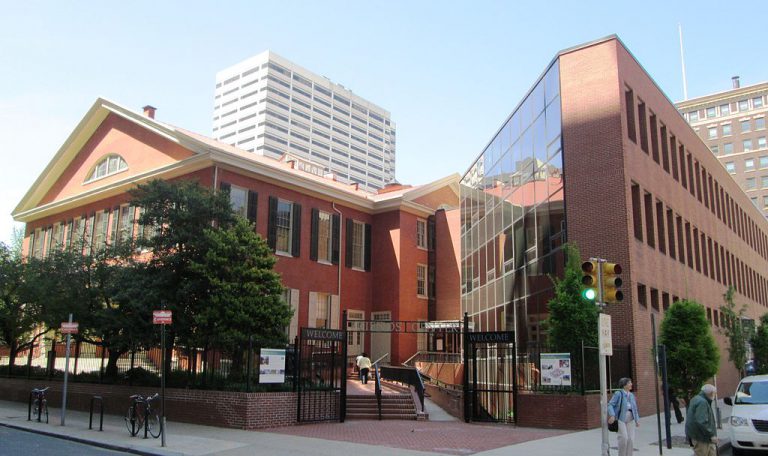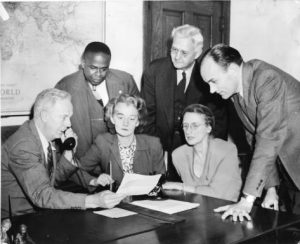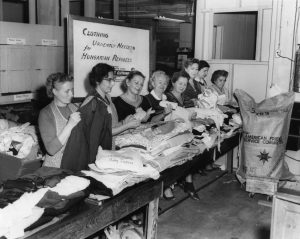American Friends Service Committee
By Guy Aiken
Essay
The American Friends Service Committee (AFSC), co-recipient of the Nobel Peace Prize and coiner of the phrase “speak truth to power,” was founded in Philadelphia by members of the Religious Society of Friends (Quakers) in Spring 1917, shortly after the United States declared war on Germany on April 6. Over the following century, AFSC embodied the pacifist convictions and social-reform impulses of Philadelphia’s Quaker elite.
At the outset of U.S. involvement in the First World War, the major branches of U.S. Quakerism created AFSC to coordinate alternative service for young Quaker men who conscientiously refused to serve in the military after being drafted under the Selective Service Act. The alternative consisted mostly of over six hundred Quaker and other pacifist volunteers reconstructing modular housing for displaced persons along the Western Front in France under the auspices of the American Red Cross. It was a version of what William James (1842-1910) had called the “moral equivalent of war,” and AFSC saw it as a chance for Quakers and other pacifists to make a positive contribution to peace instead of taking a merely negative stance against war. After the war, between 1920 and 1924, AFSC organized and directed the feeding of over five million children in Germany.
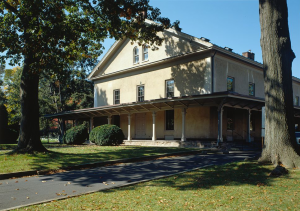
During the organization’s early years, the Philadelphia Quaker elite (professionals, educators, and business executives), with the occasional midwestern Friend, largely constituted the executive board and administrative leadership and so largely determined its mission and programs. A large contingent of early AFSC workers attended Germantown Friends Meeting. This concentration positioned AFSC on one side of theological differences between the more liberal Quakers of Philadelphia, New England, and the Mid-Atlantic and the more conservative Friends of the South, Midwest, and West. Differences rapidly grew into division, especially over AFSC’s abjuration of evangelism as an obstacle to delivering material aid and social services. As early as the mid-1920s more conservative Friends were disowning AFSC as in any way representative of American Quakerism as a whole.
Philadelphia Quaker Elite
The Philadelphia Quaker elite between the world wars was solidly middle and upper-middle-class and counted many industrial and financial executives among its ranks. These well-off Quakers generally subscribed to the middle-class Social Gospel, a liberal movement for political and economic reform whose influence on Protestantism at large had just passed its peak. Yet Philadelphia Quakers, unlike most other Friends in the country, never officially joined the major institutional expression of the Social Gospel in the United States, the Federal Council of Churches (FCC, founded in 1908). AFSC effectively fulfilled the role of the FCC for Philadelphia Quakerism; indeed, in the 1920s and 1930s AFSC often worked with the FCC on domestic projects, most notably among coal-mining families in southern Appalachia.
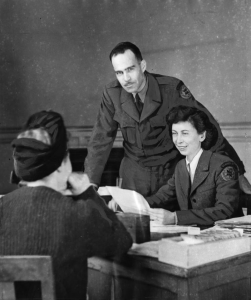
During World War II, AFSC (somewhat controversially) worked with representatives of the other “historic peace churches,” the Mennonites and Brethren, to administer the federally established Civilian Public Service (CPS) system of work camps for conscientious objectors. AFSC helped resettle European refugees in the United States, and by establishing a regional office (one of the first of several) in San Francisco, also protested Japanese-American internment and helped relocate over four thousand Japanese-American college students from the internment camps. In 1947, after another round of postwar feeding and service in Germany and on the strength also of its administration of prewar relief programs in Russia and Spain during those countries’ respective civil wars, AFSC (together with its British counterpart, the Friends Service Council) was awarded the Nobel Peace Prize on behalf of Quakers worldwide.
After World War II, AFSC resolved a long-standing internal debate over what it should prioritize in its hiring: Quakerism or practical expertise. It became increasingly professionalized and soon employed a majority non-Quaker staff, moving the debate over AFSC’s Quaker identity outside the organization to liberal Quaker circles, where it raged into the twenty-first century. Also, AFSC began to focus less and less on material aid and more and more on ending military conflict and poverty in the Global South and on improving race relations and civil rights at home. AFSC started delivering aid to refugees in Gaza in 1948 at the request of the United Nations and during its ensuing decades-long presence in the Middle East distinguished itself as one of the first organizations in the United States to call for Palestinian rights. In 1958, AFSC started working in Africa as well, aiding refugees from the Algerian War. After also administering medical aid in China and food aid in India and Bengal, AFSC entered Vietnam in 1965 and (again, somewhat controversially) aided civilians on both sides of the Vietnam War. It also provided draft counseling for thousands of young men in the United States.
“Speak Truth to Power”
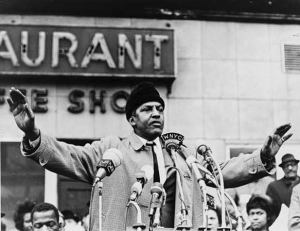
AFSC became perhaps most famous for coining the phrase “speak truth to power,” the title of a pamphlet it issued in 1955 advocating nonviolent resolution of international conflicts. Although the lead authors of Speak Truth to Power attributed the phrase to an eighteenth-century Friend, it originated with Bayard Rustin (1912-87), one of the pamphlet’s co-authors. Rustin was an African American Quaker civil rights leader from West Chester, Pennsylvania, and the chief organizer of the August 1963 March on Washington for Jobs and Freedom. AFSC itself sponsored Martin Luther King Jr. (1929-68) and Coretta Scott King (1927-2006) on a visit to India in 1959 to help strengthen the nonviolent African American civil rights movement’s ties to its Gandhian roots. AFSC also first published Martin Luther King Jr.’s “Letter from Birmingham Jail” as a stand-alone pamphlet.
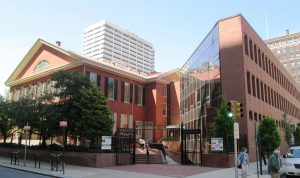
In the 1970s and 1980s, AFSC protested apartheid in South Africa as well as the proliferation of nuclear weapons in the United States and around the world. In the 1990s, AFSC established a major health clinic in Haiti and, in the midst of a famine in North Korea, advised farmers in that country on how to increase food production sustainably. In 2004, AFSC continued its practice of protesting U.S. wars by curating a travelling exhibit, “Eyes Wide Open,” which displayed a pair of boots for every American soldier killed in Iraq along with shoes representing the hundreds of thousands of civilians who also died in the most recent war. In the 2010s, AFSC focused on criminal-justice and immigration reform, opposing solitary confinement (in particular) and providing legal services for immigrants.
While AFSC became a majority non-Quaker organization with offices around the United States and on four continents, Philadelphia remained the organization’s headquarters. In the twenty-first century, the Quaker values of peace, integrity, and equality continued to animate AFSC programs.
Guy Aiken holds a Ph.D. in Religious Studies (American Religions) from the University of Virginia and is a postdoctoral fellow at Villanova University. He has published several articles, including “The American Friends Service Committee’s Mission to the Gestapo” in Peace & Change, and “Educating Tocqueville: Jared Sparks, the Boston Whigs, and Democracy in America” in the Tocqueville Review. (Author information current at time of publication.)
Copyright 2018, Rutgers University
Gallery
Links
- American Friends Service Committee
- Friends Center
- Bayard Rustin Biography (National Park Service)
- Civilian Public Service Historical Marker (ExplorePAHistory.com)
- Germantown Friends Meeting House - Historic American Buildings Survey (Library of Congress)
- Records of the Federal Council of Churches, 1894-1952 (Presbyterian Historical Society)
- "Speak Truth to Power" Pamphlet Text (Religious Society of Friends)
- The 1947 Nobel Peace Prize (Nobelprize.org)
